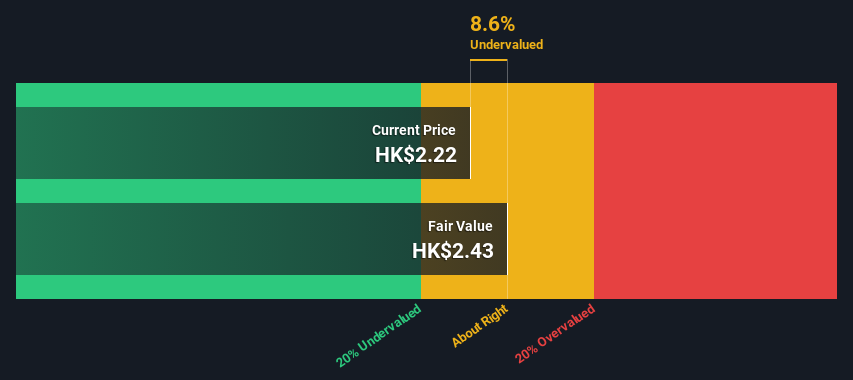- Hong Kong
- /
- Basic Materials
- /
- SEHK:743
Calculating The Fair Value Of Asia Cement (China) Holdings Corporation (HKG:743)

Key Insights
- The projected fair value for Asia Cement (China) Holdings is HK$2.43 based on 2 Stage Free Cash Flow to Equity
- Asia Cement (China) Holdings' HK$2.22 share price indicates it is trading at similar levels as its fair value estimate
- Asia Cement (China) Holdings' peers seem to be trading at a higher discount to fair value based onthe industry average of 50%
In this article we are going to estimate the intrinsic value of Asia Cement (China) Holdings Corporation (HKG:743) by taking the expected future cash flows and discounting them to their present value. This will be done using the Discounted Cash Flow (DCF) model. There's really not all that much to it, even though it might appear quite complex.
We would caution that there are many ways of valuing a company and, like the DCF, each technique has advantages and disadvantages in certain scenarios. If you want to learn more about discounted cash flow, the rationale behind this calculation can be read in detail in the Simply Wall St analysis model.
View our latest analysis for Asia Cement (China) Holdings
Step By Step Through The Calculation
We're using the 2-stage growth model, which simply means we take in account two stages of company's growth. In the initial period the company may have a higher growth rate and the second stage is usually assumed to have a stable growth rate. In the first stage we need to estimate the cash flows to the business over the next ten years. Seeing as no analyst estimates of free cash flow are available to us, we have extrapolate the previous free cash flow (FCF) from the company's last reported value. We assume companies with shrinking free cash flow will slow their rate of shrinkage, and that companies with growing free cash flow will see their growth rate slow, over this period. We do this to reflect that growth tends to slow more in the early years than it does in later years.
Generally we assume that a dollar today is more valuable than a dollar in the future, so we discount the value of these future cash flows to their estimated value in today's dollars:
10-year free cash flow (FCF) forecast
| 2025 | 2026 | 2027 | 2028 | 2029 | 2030 | 2031 | 2032 | 2033 | 2034 | |
| Levered FCF (CN¥, Millions) | CN¥390.9m | CN¥296.3m | CN¥248.1m | CN¥221.5m | CN¥206.4m | CN¥197.9m | CN¥193.6m | CN¥191.9m | CN¥192.1m | CN¥193.5m |
| Growth Rate Estimate Source | Est @ -35.54% | Est @ -24.20% | Est @ -16.27% | Est @ -10.71% | Est @ -6.82% | Est @ -4.10% | Est @ -2.20% | Est @ -0.86% | Est @ 0.07% | Est @ 0.73% |
| Present Value (CN¥, Millions) Discounted @ 7.6% | CN¥363 | CN¥256 | CN¥199 | CN¥166 | CN¥143 | CN¥128 | CN¥116 | CN¥107 | CN¥99.7 | CN¥93.4 |
("Est" = FCF growth rate estimated by Simply Wall St)
Present Value of 10-year Cash Flow (PVCF) = CN¥1.7b
The second stage is also known as Terminal Value, this is the business's cash flow after the first stage. For a number of reasons a very conservative growth rate is used that cannot exceed that of a country's GDP growth. In this case we have used the 5-year average of the 10-year government bond yield (2.3%) to estimate future growth. In the same way as with the 10-year 'growth' period, we discount future cash flows to today's value, using a cost of equity of 7.6%.
Terminal Value (TV)= FCF2034 × (1 + g) ÷ (r – g) = CN¥193m× (1 + 2.3%) ÷ (7.6%– 2.3%) = CN¥3.7b
Present Value of Terminal Value (PVTV)= TV / (1 + r)10= CN¥3.7b÷ ( 1 + 7.6%)10= CN¥1.8b
The total value, or equity value, is then the sum of the present value of the future cash flows, which in this case is CN¥3.5b. The last step is to then divide the equity value by the number of shares outstanding. Compared to the current share price of HK$2.2, the company appears about fair value at a 8.6% discount to where the stock price trades currently. Remember though, that this is just an approximate valuation, and like any complex formula - garbage in, garbage out.

The Assumptions
Now the most important inputs to a discounted cash flow are the discount rate, and of course, the actual cash flows. Part of investing is coming up with your own evaluation of a company's future performance, so try the calculation yourself and check your own assumptions. The DCF also does not consider the possible cyclicality of an industry, or a company's future capital requirements, so it does not give a full picture of a company's potential performance. Given that we are looking at Asia Cement (China) Holdings as potential shareholders, the cost of equity is used as the discount rate, rather than the cost of capital (or weighted average cost of capital, WACC) which accounts for debt. In this calculation we've used 7.6%, which is based on a levered beta of 1.095. Beta is a measure of a stock's volatility, compared to the market as a whole. We get our beta from the industry average beta of globally comparable companies, with an imposed limit between 0.8 and 2.0, which is a reasonable range for a stable business.
SWOT Analysis for Asia Cement (China) Holdings
- Debt is not viewed as a risk.
- Dividend is low compared to the top 25% of dividend payers in the Basic Materials market.
- Has sufficient cash runway for more than 3 years based on current free cash flows.
- Current share price is below our estimate of fair value.
- Paying a dividend but company is unprofitable.
Moving On:
Whilst important, the DCF calculation is only one of many factors that you need to assess for a company. DCF models are not the be-all and end-all of investment valuation. Rather it should be seen as a guide to "what assumptions need to be true for this stock to be under/overvalued?" If a company grows at a different rate, or if its cost of equity or risk free rate changes sharply, the output can look very different. For Asia Cement (China) Holdings, we've put together three essential factors you should explore:
- Risks: For instance, we've identified 2 warning signs for Asia Cement (China) Holdings (1 is potentially serious) you should be aware of.
- Future Earnings: How does 743's growth rate compare to its peers and the wider market? Dig deeper into the analyst consensus number for the upcoming years by interacting with our free analyst growth expectation chart.
- Other Solid Businesses: Low debt, high returns on equity and good past performance are fundamental to a strong business. Why not explore our interactive list of stocks with solid business fundamentals to see if there are other companies you may not have considered!
PS. Simply Wall St updates its DCF calculation for every Hong Kong stock every day, so if you want to find the intrinsic value of any other stock just search here.
If you're looking to trade Asia Cement (China) Holdings, open an account with the lowest-cost platform trusted by professionals, Interactive Brokers.
With clients in over 200 countries and territories, and access to 160 markets, IBKR lets you trade stocks, options, futures, forex, bonds and funds from a single integrated account.
Enjoy no hidden fees, no account minimums, and FX conversion rates as low as 0.03%, far better than what most brokers offer.
Sponsored ContentNew: Manage All Your Stock Portfolios in One Place
We've created the ultimate portfolio companion for stock investors, and it's free.
• Connect an unlimited number of Portfolios and see your total in one currency
• Be alerted to new Warning Signs or Risks via email or mobile
• Track the Fair Value of your stocks
Have feedback on this article? Concerned about the content? Get in touch with us directly. Alternatively, email editorial-team (at) simplywallst.com.
This article by Simply Wall St is general in nature. We provide commentary based on historical data and analyst forecasts only using an unbiased methodology and our articles are not intended to be financial advice. It does not constitute a recommendation to buy or sell any stock, and does not take account of your objectives, or your financial situation. We aim to bring you long-term focused analysis driven by fundamental data. Note that our analysis may not factor in the latest price-sensitive company announcements or qualitative material. Simply Wall St has no position in any stocks mentioned.
About SEHK:743
Asia Cement (China) Holdings
An investment holding company, manufactures and sells cement, concrete, and related products in People’s Republic of China.
Flawless balance sheet and good value.


